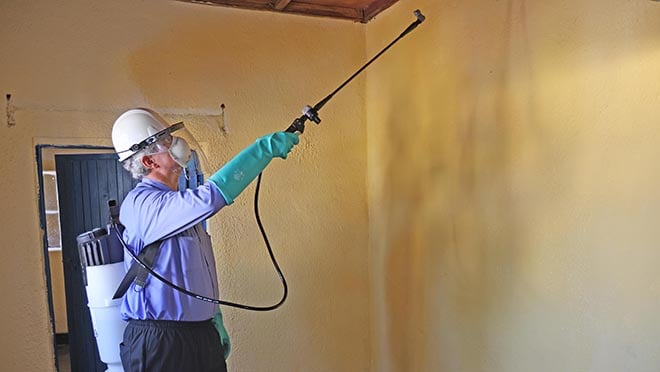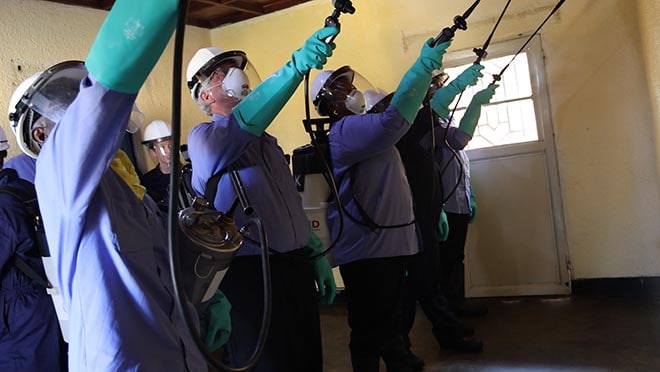Key points
- Indoor residual spraying involves coating the walls and other surfaces of the house with an effective residual insecticide, where mosquito vectors are known to rest.
- The insecticide will kill adult mosquitoes that come in contact with these treated surfaces for several months.
- To protect a community from malaria, at least 80% of households in an area must receive insecticide spray.

Overview
Indoor Residual Spraying (IRS) is a malaria prevention method that targets indoor resting mosquitoes. IRS involves coating interior walls and other sprayable surfaces in a house with a residual (long-lasting) insecticide. IRS takes advantage of the indoor resting behavior of many malaria mosquitoes that rest on these surfaces inside houses after taking a blood meal. The insecticide will kill mosquitoes and other insects that come in contact with these treated surfaces for several months. IRS does not directly prevent people from being bitten by mosquitoes. However, IRS usually kills adult mosquitoes after they have fed on blood and rest on a treated surface, which shortens the mosquito's lifespan and prevents the development and subsequent transmission of malaria parasites to other people. A very high proportion of households in an area, ideally over 80%, must be treated to protect a community.

History IRS
From 1955 to 1969, the Global Malaria Eradication Program (GMEP) used IRS with DDT as the primary means to control malaria. Although the GMEP failed to eradicate infection reservoirs and end malaria transmission globally, it did manage to eliminate the disease from certain areas and significantly reduce its prevalence in others. However, several challenges emerged that threatened the success of the IRS programs. There were concerns about the environmental impact of DDT, the primary insecticide used, and mosquito resistance to it. Other effective insecticides were developed, but they were more expensive than DDT.
In the 1970s, the responsibility for maintaining IRS campaigns was shifted to national malaria programs in endemic countries, but many of these programs were unable to continue due to the high cost of operations. Hence, most of the IRS programs collapsed, and malaria soon resurged to pre-campaign levels in many areas following the withdrawal of IRS campaigns.
In the 1980s and 1990s, IRS programs were largely disbanded due to decreased funding, negative publicity, environmental concerns about residual insecticides, and resistance to DDT.
However, in the 2000s, there was a renewed interest in IRS as a malaria prevention tool; under initiatives such as the Roll Back Malaria Partnership (RBM), the Global Fund to Fight AIDS, Tuberculosis and Malaria (GFATM), and the U.S. President's Malaria Initiative (PMI) some countries reintroduced or scaled up IRS.
Newer non-pyrethroid insecticides such as pirimiphos-methyl, clothianidin, and broflanilide may be contributing to the management of insecticide resistance, and IRS campaigns have been widely implemented across sub-Saharan Africa to prevent malaria. Between 2000 and 2015, IRS campaigns are estimated to have contributed to approximately 10% of the 633 million malaria cases averted in Africa.
